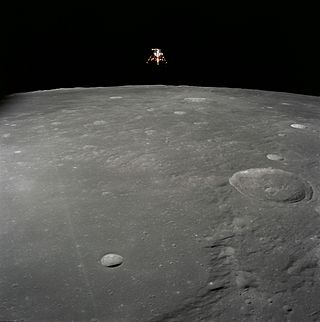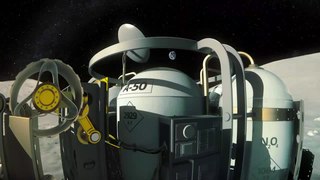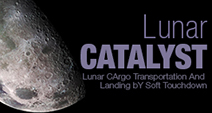
Masten Space Systems was an aerospace manufacturer startup company in Mojave, California that was developing a line of vertical takeoff, vertical landing (VTVL) rockets, initially for uncrewed research sub-orbital spaceflights and eventually intended to support robotic orbital spaceflight launches.

The physical exploration of the Moon began when Luna 2, a space probe launched by the Soviet Union, made an impact on the surface of the Moon on September 14, 1959. Prior to that the only available means of exploration had been observation from Earth. The invention of the optical telescope brought about the first leap in the quality of lunar observations. Galileo Galilei is generally credited as the first person to use a telescope for astronomical purposes; having made his own telescope in 1609, the mountains and craters on the lunar surface were among his first observations using it.

The Google Lunar XPRIZE (GLXP), sometimes referred to as Moon 2.0, was a 2007–2018 inducement prize space competition organized by the X Prize Foundation, and sponsored by Google. The challenge called for privately funded teams to be the first to land a lunar rover on the Moon, travel 500 meters, and transmit back to Earth high-definition video and images.

Astrobotic Technology is an American privately held company that is developing space robotics technology for lunar and planetary missions. It was founded in 2007 by Carnegie Mellon professor Red Whittaker and his associates with the goal of winning the Google Lunar X Prize. The company is based in Pittsburgh, Pennsylvania. The first launch of one of its spacecraft, the Peregrine lunar lander, is expected to take place in the first quarter of 2023.

Hakuto (ハクト) or formerly White Label Space (ホワイトレーベルスペース) was a team formed in early 2008 by a group of experienced space professionals inspired by the challenge of the Google Lunar X PRIZE to develop a robotic Moon exploration mission.
Planetary Transportation Systems (PTS), formerly known as PTScientists and Part-Time Scientists, is a Berlin-based aerospace company. They developed the robotic lunar lander "ALINA" and seek to land on the Moon with it. They became the first German team to officially enter the Google Lunar X-Prize competition on June 24, 2009, but failed to reach the finals in 2017 for lack of a launch contract. During the summer of 2019, the company filed for bankruptcy, and the ALINA project was put on hold. In July 2021, PTS was selected with ArianeGroup to build ESA's ASTRIS kick-stage.

A lunar rover or Moon rover is a space exploration vehicle designed to move across the surface of the Moon. The Apollo Program's Lunar Roving Vehicle was driven on the Moon by members of three American crews, Apollo 15, 16, and 17. Other rovers have been partially or fully autonomous robots, such as the Soviet Union's Lunokhods and the Chinese Yutus. Three countries have had operating rovers on the Moon: the Soviet Union, the United States and China. An Indian mission failed while Japan and Greece currently have planned missions.
Moon Express is an American privately held early-stage company formed in 2010 by a group of Silicon Valley and space entrepreneurs. It had the goal of winning the $30 million Google Lunar X Prize, and of ultimately mining the Moon for natural resources of economic value. The company was not able to make a launch attempt to reach the Moon by March 31, 2018, the deadline for the prize.

Artemis 2 is the second scheduled mission of NASA's Artemis program, and the first scheduled crewed mission of NASA's Orion spacecraft, currently planned to be launched by the Space Launch System (SLS) in May 2024. The crewed Orion spacecraft will perform a lunar flyby test and return to Earth. This is planned to be the first crewed spacecraft to travel beyond low Earth orbit since Apollo 17 in 1972. Formerly known as Exploration Mission-2 (EM-2), the mission was renamed after the introduction of the Artemis program. Originally, the crewed mission was intended to collect samples from a captured asteroid in lunar orbit by the now canceled robotic Asteroid Redirect Mission. This is also planned to be the first crewed launch from LC-39B since STS-116.

Resource Prospector is a cancelled mission concept by NASA of a rover that would have performed a survey expedition on a polar region of the Moon. The rover was to attempt to detect and map the location of volatiles such as hydrogen, oxygen and lunar water which could foster more affordable and sustainable human exploration to the Moon, Mars, and other Solar System bodies.
The International Lunar Observatory (ILO) is a private scientific and commercial lunar mission by International Lunar Observatory Association (ILOA) of Kamuela, Hawaii to place a small observatory near the South Pole of the Moon to conduct astrophysical studies using an optical telescope. The mission, planned for launch in 2022 or 2023, aims to prove a conceptual design for a lunar observatory that would be reliable, low cost, and fast to implement. A precursor mission, ILO-X consisting of two small imagers, is set to launch in 2022 aboard the Intuitive Machines IM-1 mission to Vallis Schröteri on the Moon's near side. It is hoped to be a technology precursor to a future observatories on the Moon, and other commercial initiatives.

Commercial Lunar Payload Services (CLPS) is a NASA program to contract transportation services able to send small robotic landers and rovers to the Moon's south polar region mostly with the goals of scouting for lunar resources, testing in situ resource utilization (ISRU) concepts, and performing lunar science to support the Artemis lunar program. CLPS is intended to buy end-to-end payload services between Earth and the lunar surface using fixed priced contracts. The program was extended to add support for large payloads starting after 2025.
Team AngelicvM is a private company based in Chile that plans to deploy a small rover on the Moon. Their rover, called Unity, is one of various rovers that will be carried by the commercial Peregrine lander manufactured by Astrobotic Technology.
ispace Inc. is a private Japanese company developing robotic spacecraft technologies to build landers and rovers to compete for both transportation and exploration mission contracts from space agencies and private industry. ispace will enable clients who may want to discover, map, and use the natural lunar resources.

Nova-C is a lunar lander designed by the private company Intuitive Machines to deliver small commercial payloads to the surface of the Moon.

Intuitive Machines, Inc. is a publicly-traded American company headquartered in Houston, Texas. It was founded in 2013 by Stephen Altemus, Kam Ghaffarian, and Tim Crain. Intuitive Machines is completing its lunar program which will provide lunar surface access, lunar orbit delivery, and communications at lunar distance. Intuitive Machines holds three NASA contracts, under the space agency's Commercial Lunar Payload Services (CLPS) initiative, to deliver payloads to the lunar surface. The formerly privately-held Intuitive Machines, LLC completed a merger with special-purpose acquisition company (SPAC) Inflection Point Acquisition Corp. in February 2023, and incorporated in the State of Delaware. The sock trades on the Nasdaq exchange under the ticker symbol LUNR.
CubeRover is a class of planetary rover with a standardized modular format meant to accelerate the pace of space exploration. The idea is equivalent to that of the successful CubeSat format, with standardized off-the-shelf components and architecture to assemble small units that will be all compatible, modular, and inexpensive.

The Artemis program is a robotic and human Moon exploration program led by the United States' National Aeronautics and Space Administration (NASA) along with three partner agencies: European Space Agency (ESA), Japan Aerospace Exploration Agency (JAXA), and Canadian Space Agency (CSA). The Artemis program intends to reestablish a human presence on the Moon for the first time since the Apollo 17 mission in 1972. The major components of the program are the Space Launch System (SLS), Orion spacecraft, Lunar Gateway space station and the commercial Human Landing Systems. The program's long-term goal is to establish a permanent base camp on the Moon and facilitate human missions to Mars.

VIPER is a lunar rover developed by NASA, and currently planned to be delivered to the surface of the Moon in November 2024. The rover will be tasked with prospecting for lunar resources in permanently shadowed areas in the lunar south pole region, especially by mapping the distribution and concentration of water ice. The mission builds on a previous NASA rover concept called Resource Prospector, which was cancelled in 2018.













